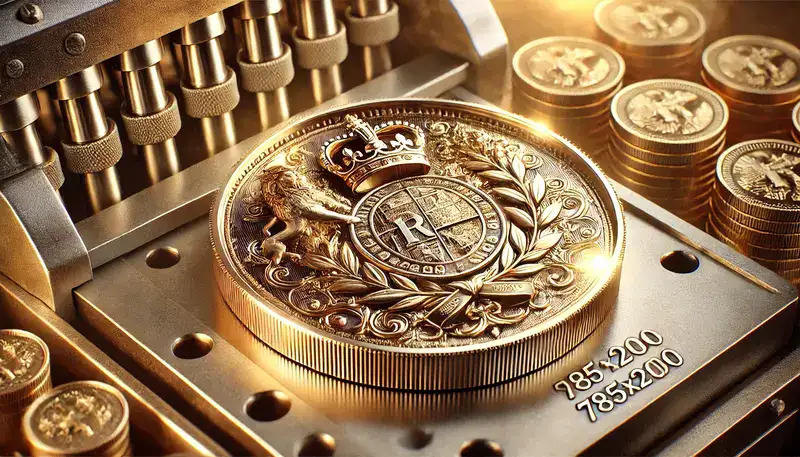
Introduction to The Royal Mint Proof Coins
The Royal Mint has a long and prestigious history of producing coins that celebrate British heritage, historical events, and key cultural moments. Among these coins, proof coins hold a special place. Known for their superior quality, detail, and finish, proof coins are highly valued by collectors for their artistry and precision. This article introduces proof coins, their significance, and the various types available, including gold, silver, and platinum proof coins.
What Are Proof Coins?
Proof Coins are special editions of standard coins that are crafted to the highest standards. Unlike regular circulation coins, which are produced quickly and in high volumes, proof coins are meticulously made to ensure every detail stands out. Each coin is struck multiple times with polished dies, resulting in a flawless finish, sharp design, and mirror-like background. This method is labor-intensive and results in a limited number of proof coins, making them more exclusive and highly sought after by collectors.
Read more on how proof coins differ from brilliant uncirculated coins.
Understanding Proof Coins Meaning and History
The term "proof" originates from the process of creating a "proof" strike for inspection and quality testing. In the 18th century, proof coins were made to demonstrate the quality of minting and were often preserved as examples. Over time, the tradition of producing proof coins for collectors began, and today, The Royal Mint creates proof versions of select coins, celebrating British history and culture.
Types of Royal Mint Proof Coins
The Royal Mint offers proof coins in various metals, including gold, silver, and platinum. Each type has unique qualities that appeal to different collectors, depending on their interests and collection goals.
1. Gold Proof Coins
Gold Proof Coins are some of the most prestigious proof coins produced by The Royal Mint. Crafted from high-quality gold, these coins are typically created in limited editions, adding to their exclusivity and allure. Gold proof coins are often issued to commemorate significant events, such as royal milestones or anniversaries. They are struck with the same high standards as other proof coins but are unique in their rich, golden luster.
Popular examples of gold proof coins include the Gold Britannia Proof Coin, which celebrates British resilience and tradition, and the Sovereign Gold Proof Coin, known for its rich history dating back to the early 19th century.
2. Silver Proof Coins
Silver Proof Coins are another popular choice among collectors. Made from high-grade silver, these coins offer the same high-quality finish and intricate detailing as gold proof coins, but at a more accessible price point. Silver proof coins often feature detailed designs celebrating historical events, literature, and cultural symbols that are quintessentially British.
Notable examples include the Silver Britannia Proof Coin and silver proof coins commemorating British authors and historical figures. These coins are an affordable yet elegant way for collectors to engage with British history through coin collecting.
3. Platinum Proof Coins
Platinum proof coins are among the rarest and most luxurious offerings from The Royal Mint. Known for their durability and unique appearance, platinum coins are prized by collectors for their rarity. Platinum proof coins often feature unique designs and are usually minted in limited quantities, adding to their appeal for those interested in premium collectibles.
4. Other Types of Proof Coins
The Royal Mint also produces proof coins in other metals, including copper-nickel alloys, to cater to a wide audience of collectors. These coins still retain the high-quality finish and fine detailing associated with proof coins but are available at an even more affordable price point, making them accessible to new collectors or those interested in building a diverse collection.
5. Graded Proof Coins
Proof Coins often achieve high grades due to their quality minting process. Companies like NGS and PCGS provide grading servcies and information on how many of any particular coin have acheieved a grade.
How to Recognize a Proof Coin
Proof coins are distinct from regular coins in several ways:
- Finish: Proof coins have a mirror-like surface and frosted details, giving them a unique contrast.
- Striking Process: Proof coins are struck multiple times, enhancing their fine details and ensuring a flawless finish.
- Packaging: Proof coins are often sold in premium packaging, complete with certificates of authenticity and detailed information about the coin's design and significance.
Why Collect Proof Coins?
For many, proof coins are more than just coins, they're pieces of art that reflect history, culture, and craftsmanship. They hold a unique place in the world of numismatics (coin collecting) due to their limited production, unique designs, and high-quality finish. Collecting proof coins from The Royal Mint allows individuals to celebrate British heritage and milestones while enjoying the beauty and detail that each coin offers.
Proof coins also make memorable gifts for special occasions, as they often commemorate significant events, such as royal anniversaries or national achievements. However, it's essential to remember that while proof coins may hold value to collectors, this article does not offer investment advice. Collectors should consider proof coins primarily for their historical and aesthetic appeal.
What are NIFC coins?
Proof coins are often released as NIFC coins.
NIFC means coins Not Intended For Circulation hence they do not enter general coin circulation and are released as collectible coins only.
Final Thoughts on Royal Mint Proof Coins
The Royal Mint's proof coins are a unique way to own a piece of British history, whether it's in the form of a gleaming gold coin, a meticulously detailed silver coin, or an exclusive platinum piece. Each coin is a testament to the artistry and heritage of British minting, capturing moments and symbols that resonate with collectors across the UK and beyond.
Useful links for proof coins
- 2pound.co.uk - All Two Pound Coins in UK.
- Bunc.co.uk - Brilliant Uncirculated Coins.
- UK Coins - Numismatic website for UK Coins.